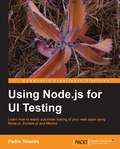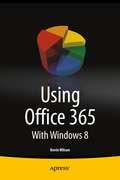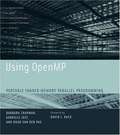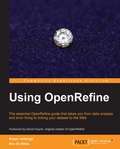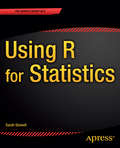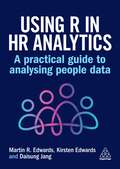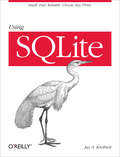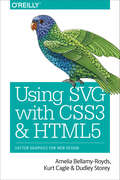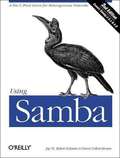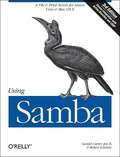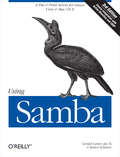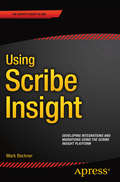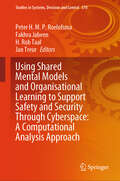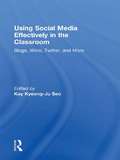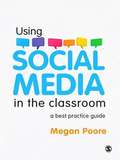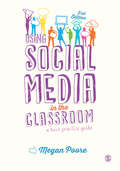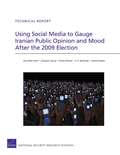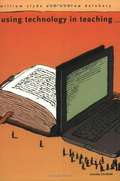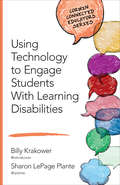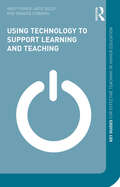- Table View
- List View
Using Node.js for UI Testing
by Pedro TeixeiraFull of techniques and tips for simulating user interactions and verifying that your application is behaving correctly.This book is for frontend and backend web application developers that know how to program in JavaScript.
Using Office 365
by Kevin WilsonLearn Office the easy way, no jargon. Clear, concise and to the point. . . Using Microsoft Office 365, is the essential step by step guide to getting the most out of the traditional Microsoft Office applications (not SharePoint), providing a complete resource for both the beginner and the enthusiast. Techniques are illustrated step-by-step using photography and screen prints throughout, together with concise, easy to follow text from an established expert in the field, provide a comprehensive guide to office applications. Whether you are new to Microsoft Office, an experienced user or studying a computer skills course this book will provide you with a firm grasp of the underpinning foundations and equip you with the skills needed to use Office like a pro. What you'll learn How to use the new Microsoft Office 365 What is Skydrive and how to use it How to use the new Microsoft Word 2013 as part of Office 365 How to give presentations and use the Powerpoint 2013 as part of Office 365 How to do spreadsheets with Excel 2013 as part of Office 365 Who this book is for This book is for those new to Office 365 as well as those who are new to Office in general. Table of Contents 1. Microsoft Office 365 2. Microsoft Skydrive 3. Microsoft Word 2013 4. PowerPoint 2013 5. Giving Presentations 6. Microsoft Excel 2013
Using OpenMP: Portable Shared Memory Parallel Programming
by Barbara Chapman Gabriele Jost David J. Kuck Ruud Van Der PasThis book should provide an excellent introduction to beginners, and the performance section should help those with some experience who want to push OpenMP to its limits.
Using OpenRefine
by Max De Wilde Ruben VerborghThe book is styled on a Cookbook, containing recipes - combined with free datasets - which will turn readers into proficient OpenRefine users in the fastest possible way.This book is targeted at anyone who works on or handles a large amount of data. No prior knowledge of OpenRefine is required, as we start from the very beginning and gradually reveal more advanced features. You don't even need your own dataset, as we provide example data to try out the book's recipes.
Using R for Statistics
by Sarah StowellUsing R for Statistics will get you the answers to most of the problems you are likely to encounter when using a variety of statistics. This book is a problem-solution primer for using R to set up your data, pose your problems and get answers using a wide array of statistical tests. The book walks you through R basics and how to use R to accomplish a wide variety statistical operations. You'll be able to navigate the R system, enter and import data, manipulate datasets, calculate summary statistics, create statistical plots and customize their appearance, perform hypothesis tests such as the t-tests and analyses of variance, and build regression models. Examples are built around actual datasets to simulate real-world solutions, and programming basics are explained to assist those who do not have a development background. After reading and using this guide, you'll be comfortable using and applying R to your specific statistical analyses or hypothesis tests. No prior knowledge of R or of programming is assumed, though you should have some experience with statistics. What you'll learn How to apply statistical concepts using R and some R programming How to work with data files, prepare and manipulate data, and combine and restructure datasets How to summarize continuous and categorical variables What is a probability distribution How to create and customize plots How to do hypothesis testing How to build and use regression and linear models Who this book is for No prior knowledge of R or of programming is assumed, making this book ideal if you are more accustomed to using point-and-click style statistical packages. You should have some prior experience with statistics, however. Table of Contents 1. R Fundamentals 2. Working with Data Files 3. Preparing and Manipulating Data 4. Combining and Restructuring Data Sets 5. Continuous Variables 6. Tabular Data 7. Probability Distribution 8. Creating Plots 9. Customizing Plots 10. Hypothesis Tests 11. Regression and Linear Models 12. Appendix A: Basic Programming with R 13. Appendix B: Add-on Packages 14: Appendix C: Data Sets
Using R in HR Analytics: A Practical Guide to Analysing People Data
by Dr Martin Edwards Kirsten Edwards Daisung JangConfidently analyse your organization's HR data using R and R Studio to gain insights that improve people strategy and business decision-making. Effective use of HR data has the power to transform a business. However, this is only possible if HR practitioners have the knowledge, skills and confidence to analyse the data and to draw evidence-based insights from it. This book is the practical guide that HR professionals need. Through worked examples, this book shows readers how to carry out and interpret analyses of HR data in areas such as recruitment, performance, employee engagement and diversity. People professionals are then shown how to use the results to develop robust people strategies and to support more effective evidence-based decision-making. Using R in HR Analytics provides a thorough grounding in the differences between descriptive reporting and predictive analytics as well as the methods and measures used to identify the validity of results. There is also expert guidance on the role of artificial intelligence, machine learning and large language modelling on HR analytics. Written for HR professionals at any level, there is essential coverage of data privacy and the ethical considerations of using people data. Online resources include sample datasets to allow readers to practice analysing HR data.
Using SANs and NAS: Help for Storage Administrators
by W. Curtis PrestonData is the lifeblood of modern business, and modern data centers have extremely demanding requirements for size, speed, and reliability. Storage Area Networks (SANs) and Network Attached Storage (NAS) allow organizations to manage and back up huge file systems quickly, thereby keeping their lifeblood flowing. W. Curtis Preston's insightful book takes you through the ins and outs of building and managing large data centers using SANs and NAS.As a network administrator you're aware that multi-terabyte data stores are common and petabyte data stores are starting to appear. Given this much data, how do you ensure that it is available all the time, that access times and throughput are reasonable, and that the data can be backed up and restored in a timely manner? SANs and NAS provide solutions that help you work through these problems, with special attention to the difficulty of backing up huge data stores. This book explains the similarities and differences of SANs and NAS to help you determine which, or both, of these complementing technologies are appropriate for your network. Using SANs, for instance, is a way to share multiple devices (tape drives and disk drives) for storage, while NAS is a means for centrally storing files so they can be shared. Preston exams each technology with a vendor neutral approach, starting with the building blocks of a SAN and how they can be assembled for effective storage solutions. He covers day-to-day management and backup and recovery for both SANs and NAS in detail. Whether you're a seasoned storage administrator or a network administrator charged with taking on this role, you'll find all the information you need to make informed architecture and data management decisions. The book fans out to explore technologies such as RAID and other forms of monitoring that will help complement your data center. With an eye on the future, other technologies that might affect the architecture and management of the data center are explored. This is sure to be an essential volume in any network administrator's or storage administrator's library.
Using SPSS for Windows and Macintosh: Analyzing and Understanding Data
by Neil Salkind Samuel GreenThe development of easy-to-use statistical software like SPSS has changed the way statistics is being taught and learned. Even with these advancements, however, students sometimes still find statistics a tough nut to crack. Using SPSS for Windows and Macintosh, 7/e, guides students through basic SPSS techniques using step-by-step descriptions and explaining in detail how to avoid common pitfalls in the study of statistics.
Using SQLite: Small. Fast. Reliable. Choose Any Three. (O'reilly Ser.)
by Jay A. KreibichApplication developers, take note: databases aren't just for the IS group any more. You can build database-backed applications for the desktop, Web, embedded systems, or operating systems without linking to heavy-duty client-server databases such as Oracle and MySQL. This book shows you how to use SQLite, a small and lightweight relational database engine that you can build directly into your application.With SQLite, you'll discover how to develop a database-backed application that remains manageable in size and complexity. This book guides you every step of the way. You'll get a crash course in data modeling, become familiar with SQLite's dialect of the SQL database language, and much more.Learn how to maintain localized storage in a single file that requires no configurationBuild your own SQLite library or use a precompiled distribution in your applicationGet a primer on SQL, and learn how to use several language functions and extensionsWork with SQLite using a scripting language or a C-based language such as C# or Objective-CUnderstand the basics of database design, and learn how to transfer what you already know to SQLiteTake advantage of virtual tables and modules"Complex SQL concepts explained clearly."--D. Richard Hipp, creator of SQLite
Using SVG with CSS3 and HTML5: Vector Graphics for Web Design
by Amelia Bellamy-Royds Kurt Cagle Dudley StoreyUsing Scalable Vector Graphics (SVG) for illustrations only scratches the surface of this format’s potential on the web. With this practical guide, you’ll learn how to use SVG not only for illustrations but also as graphical documents that you can integrate into complex HTML5 web pages, and style with custom CSS. Web developers will discover ways to adapt designs by adding data based graphics, dynamic styles, interaction, or animation.Divided into five parts, this book includes:SVG on the web: Understand how SVG works with HTML, CSS, and JavaScript to define graphicsDrawing with markup: Learn the vector language of x and y coordinates that let SVG create basic and custom shapesPutting graphics in their place: Use the coordinate system to draw SVG shapes and text at different scales and positionsArtistic touches: Explore how color is used, how strokes are created and manipulated, and how graphical effects like filters, clipping, and masking are appliedSVG as an application: Make your graphic more accessible to humans and computers, and learn how to make it interactive or animated
Using Samba, 2nd Edition
by Robert Eckstein David Collier-Brown Jay TsUsing Samba, Second Edition is a comprehensive guide to Samba administration. This new edition covers all versions of Samba from 2.0 to 2.2, including selected features from an alpha version of 3.0, as well as the SWAT graphical configuration tool. Updated for Windows 2000, ME, and XP, the book also explores Samba's new role as a primary domain controller and domain member server, its support for the use of Windows NT/2000/XP authentication and filesystem security on the host Unix system, and accessing shar
Using Samba, 3rd Edition
by Robert Eckstein Jay Ts Gerald CarterThis book is the comprehensive guide to Samba administration, officially adopted by the Samba Team. Wondering how to integrate Samba's authentication with that of a Windows domain? How to get Samba to serve Microsoft Dfs shares? How to share files on Mac OS X? These and a dozen other issues of interest to system administrators are covered. A whole chapter is dedicated to troubleshooting! The range of this book knows few bounds. Using Samba takes you from basic installation and configuration -- on both the client and server side, for a wide range of systems -- to subtle details of security, cross-platform compatibility, and resource discovery that make the difference between whether users see the folder they expect or a cryptic error message. Integration with Active Directory and OpenLDAP Migrating from Windows NT 4.0 domains to Samba Delegating administrative tasks to non-root users Central printer management Advanced file serving features, such as making use of Virtual File System (VFS) plugins. Samba is a cross-platform triumph: robust, flexible and fast, it turns a Unix or Linux system into a file and print server for Microsoft Windows network clients. This book will help you make your file and print sharing as powerful and efficient as possible. The authors delve into the internals of the Windows activities and protocols to an unprecedented degree, explaining the strengths and weaknesses of each feature in Windows domains and in Samba itself. Whether you're playing on your personal computer or an enterprise network, on one note or a full three-octave range, Using Samba will give you an efficient and secure server. The current edition covers such advanced 3.x features as:
Using Samba: A File & Print Server for Linux, Unix & Mac OS X
by Robert Eckstein Jay Ts Gerald CarterThis book is the comprehensive guide to Samba administration, officially adopted by the Samba Team. Wondering how to integrate Samba's authentication with that of a Windows domain? How to get Samba to serve Microsoft Dfs shares? How to share files on Mac OS X? These and a dozen other issues of interest to system administrators are covered. A whole chapter is dedicated to troubleshooting! The range of this book knows few bounds. Using Samba takes you from basic installation and configuration -- on both the client and server side, for a wide range of systems -- to subtle details of security, cross-platform compatibility, and resource discovery that make the difference between whether users see the folder they expect or a cryptic error message.The current edition covers such advanced 3.x features as:Integration with Active Directory and OpenLDAPMigrating from Windows NT 4.0 domains to SambaDelegating administrative tasks to non-root usersCentral printer managementAdvanced file serving features, such as making use of Virtual File System (VFS) plugins.Samba is a cross-platform triumph: robust, flexible and fast, it turns a Unix or Linux system into a file and print server for Microsoft Windows network clients. This book will help you make your file and print sharing as powerful and efficient as possible. The authors delve into the internals of the Windows activities and protocols to an unprecedented degree, explaining the strengths and weaknesses of each feature in Windows domains and in Samba itself.Whether you're playing on your personal computer or an enterprise network, on one note or a full three-octave range, Using Samba will give you an efficient and secure server.
Using Scribe Insight
by Mark BecknerThe Scribe platform is an essential toolkit for anyone developing a migration or integration with CRM platforms. Understanding how to utilize the workbench, console, adapters, publisher, and other components in Scribe will ensure you have a rapid development toolkit that will drastically reduce your workload and timeline. In Using Scribe Insight, you'll learn to build your integrations and migrations with the minimal amount of effort, what shortcuts can be taken to simplify and reduce your labor, and what techniques can be used to keep your solutions as simple as possible. You'll find discussions that span the full product, from installation and configuration of the core product and use of the development workbench to advanced concepts around mapping, administration, troubleshooting, and optimization of packages. You'll also be introduced to Scribe Online, how to do basic development within the environment, and how to determine when to develop solutions in Online vs. Insight What you'll learn Build rapid solutions for complex migration and integration requirements Approaches to advanced mapping techniques Ways to optimize packages and increase performance Utilize the Publisher and MSMQ Understand troubleshooting and administration Who this book is for All developers or solution architects working within the CRM space, including Salesforce and Dynamics CRM, will eventually need to either migrate or integrate data from previous versions or external systems. Scribe is the leading platform for these integrations and migrations. Table of Contents 1 - Installing and Configuring Scribe Insight 2 - Building and Testing Packages with the Workbench 3 - Data Mapping Techniques 4 - Advanced Development Techniques 5 - Deploying and Scheduling Packages in the Console 6 - Adapters, Publishers, and Queues 7 - Performance and Optimization of Solutions 8 - Administration and Troubleshootin
Using Shared Mental Models and Organisational Learning to Support Safety and Security Through Cyberspace: A Computational Analysis Approach (Studies in Systems, Decision and Control #570)
by Jan Treur Peter H. M. P. Roelofsma Fakhra Jabeen H. Rob TaalEnsuring patient safety and security through cyberspace requires that all care professionals operate as a team and community . In order to be successful, it is of paramount importance that all members of the team have a shared understanding of the diagnosis, the condition of the patient, the secure use of medical devices and the plan of action. At present, to ensure that all mem bers have this 'shared mental model', members communicate and observe each other's actions. Based upon this information, members sho uld be able to confirm if indeed all have a shared mental model and speak up when deviations in one or more members and/or processes are suspected. From a group dynamical and information processing perspective, this verification process is known to be very vulnerable: how can red flags be detected in complicated surgery settings and do members feel psychologically safe enough to speak up when they have concerns about being on the same page as the rest of their team? This book presents a new approach for saf ety and security through cyberspace through introducing a concept of co designed clinical pathways supported by the AI coach. The AI coach will be an intervention for both improving hospital wide safety and security through cyberspace. The AI Coach will empower users by supporting and facilitating the development of a shared mental model for team and organisational learning. The AI coach will function as an information, communication, cooperation and decision support system. The book advises to incorporate issues or cybersecurity risk management into the total safety and security process, among others through co-creating security.
Using Social Media Effectively in the Classroom: Blogs, Wikis, Twitter, and More
by Kay SeoThe rapid expansion of blogs, Twitter, wikis, and virtual worlds has dramatically transformed the landscape of education. Through highly accessible networks, these new media can integrate students into a learning community by enabling them to create, customize, and share content online. Using Social Media Effectively in the Classroom shows educators how to: utilize social media to best support learners, resolve potential problems, create a powerful sense of community within user-centered Web 2.0 technologies. Moving beyond basic explanations of technologies and how to use them, this book provides research-based, jargon-free, practical examples of what works, what doesn’t, and why when it comes to social media. Organized according to the systematic process of instructional design, contributors describe innovative strategies for incorporating social media into educational settings as well as significant issues to be taken into consideration at each phase of planning, designing, teaching, and evaluation.
Using Social Media for Global Security
by Ravi Gupta Hugh BrooksEssential reading for cybersecurity professionals, security analysts, policy experts, decision-makers, activists, and law enforcement!During the Arab Spring movements, the world witnessed the power of social media to dramatically shape events. Now this timely book shows government decision-makers, security analysts, and activists how to use the social world to improve security locally, nationally, and globally--and cost-effectively. Authored by two technology/behavior/security professionals, Using Social Media for Global Security offers pages of instruction and detail on cutting-edge social media technologies, analyzing social media data, and building crowdsourcing platforms.The book teaches how to collect social media data and analyze it to map the social networks of terrorists and sex traffickers, and forecast attacks and famines. You will learn how to coalesce communities through social media to help catch murderers, coordinate disaster relief, and collect intelligence about drug smuggling from hard-to-reach areas. Also highlighting dramatic case studies drawn from the headlines, this crucial book is a must-read.Illustrates linguistic, correlative, and network analysis of OSINTExamines using crowdsourcing technologies to work and engage with populations globally to solve security problemsExplores how to ethically deal with social media data without compromising people's rights to privacy and freedom of expressionShows activists fighting against oppressive regimes how they can protect their identities onlineIf you're responsible for maintaining local, national or global security, you'll want to read Using Social Media for Global Security.
Using Social Media in the Classroom
by Megan PooreHow much do you know about using social media in your teaching?<P><P> Using Social Media in the Classroom is an essential guide to Web 2.0 sites and services, providing both an overview of different types of digital technologies as well as constructive guidance on how to safely and intelligently use them as tools for learning.<P> This comprehensive, accessible textbook combines practical information on using all forms of social media for educational purposes and provides indispensable advice on how to tackle issues arising from social media use in the classroom.<P> Analysis of important contemporary topics is also included:<P> * digital literacy and new modes of learning <P> * digital participation and overcoming the 'digital divide' <P> * cyberbullying and understanding risk online <P> An accompanying Wiki website including additional resources and handouts supporting the book can be found at www.sagepub.co.uk/poore allowing you access to Megan, her additional resources, and any other materials other students post and share.<P> This is crucial reading for all students undertaking undergraduate and postgraduate teacher education courses, and practising teachers seeking to improve their understanding of using social media for teaching in informed and appropriate ways.<P> Megan Poore is Assistant Professor in Teacher Education at the University of Canberra.
Using Social Media in the Classroom: A Best Practice Guide
by Megan Poore‘A book for every teacher’s bookshelf. This book gives a comprehensive overview of the tools and apps that can be used to help turn a mediocre teaching session into an outstanding one.’ - Cheryl Hine, Leeds City College ‘Megan Poore’s updated text is needed more than ever, as social media becomes increasingly integrated in many aspects of education. I would recommend it to all practising teachers and trainee teachers, whatever their subject.’ - Sue Howarth, University of Worcester This is an essential guide to using social media to enhance teaching and learning in schools. It combines practical information on using all forms of social media for educational purposes and provides indispensable advice on how to tackle issues arising from social media use in the classroom. Key topics include: using blogs, wikis, social media networks and podcasting, digital literacy and new modes of learning, digital participation, cyberbullying and understanding risk online. This second edition includes: · Reflective tasks in each chapter inviting you to critically consider important aspects of using social media in education. · Expanded coverage of game-based learning and mobile learning. · New examples tailored for use in primary and secondary schools. · A website including additional resources and handouts can be found at study.sagepub.com/poore2e. This is essential reading for anyone training to teach in schools, and experienced teachers seeking to improve their understanding of using social media for teaching in informed and appropriate ways.
Using Social Media in the Classroom: A Best Practice Guide
by Megan Poore'A book for every teacher's bookshelf. This book gives a comprehensive overview of the tools and apps that can be used to help turn a mediocre teaching session into an outstanding one.' - Cheryl Hine, Leeds City College 'Megan Poore's updated text is needed more than ever, as social media becomes increasingly integrated in many aspects of education. I would recommend it to all practising teachers and trainee teachers, whatever their subject.' - Sue Howarth, University of Worcester This is an essential guide to using social media to enhance teaching and learning in schools. It combines practical information on using all forms of social media for educational purposes and provides indispensable advice on how to tackle issues arising from social media use in the classroom. Key topics include: using blogs, wikis, social media networks and podcasting, digital literacy and new modes of learning, digital participation, cyberbullying and understanding risk online. This second edition includes: · Reflective tasks in each chapter inviting you to critically consider important aspects of using social media in education. · Expanded coverage of game-based learning and mobile learning. · New examples tailored for use in primary and secondary schools. · A website including additional resources and handouts can be found at study.sagepub.com/poore2e. This is essential reading for anyone training to teach in schools, and experienced teachers seeking to improve their understanding of using social media for teaching in informed and appropriate ways.
Using Social Media to Gauge Iranian Public Opinion and Mood After the 2009 Election
by Alireza Nader S. R. Bohandy Parisa Roshan Sara Beth Elson Douglas YeungIn the months after the contested Iranian presidential election in June 2009, Iranians spoke out about the election using Twitter—a social media service that allows users to send short text messages, called tweets, with relative anonymity. This research analyzed more than 2.5 million tweets discussing the Iran election that were sent in the nine months following it, drawing insights into Iranian public and mood in the post-election period.
Using Technology in Teaching
by William Clyde Andrew DeloheryComputers can help teachers accomplish many of their tasks more efficiently and effectively, but how can a time-strapped teacher determine which pieces of technology are likely to be most helpful? This easy-to-read book offers useful guidance for real-world situations. Organized around specific instructional goals (improving student writing, promoting collaborative learning) and commonly encountered tasks (communicating with students between class, distributing course materials), the book shows teachers at all instructional levels when and how technology can help them meet everyday challenges. Written in an anecdotal, non-technical style, the book and its accompanying CD-ROM cover how to use technology to: communicate with students distribute course materials promote collaborative learning learn through experience clarify course objectives improve student writing develop student research skills use assessment and feedback collect course materials identify plagiarism and more Teachers looking for tools to help them work better and more quickly will welcome this invaluable guide to the technology that will expedite their search.
Using Technology to Engage Students With Learning Disabilities (Corwin Connected Educators Series)
by William A. Krakower Sharon LePage PlanteLeverage technology to engage students with learning disabilities! Harness the power of today’s technology to improve learning and engagement for students with learning disabilities. By engaging students with learning disabilities using the technology already at your fingertips, you’ll see your students begin to thrive and grow in exciting new ways. In this volume in the Connected Educators Series, you’ll discover: New ideas for using assistive technology to teach core subjects and study skills How to build positive opportunities for students to show what they know Tools to provide better content accessibility How to help students connect and share through technology tools The Corwin Connected Educators series is your key to unlocking the greatest resource available to all educators: other educators. Being a Connected Educator is more than a set of actions: it’s a belief in the potential of technology to fuel lifelong learning. "Every educator can implement these methodologies to transform their learning environment into a place that honors and respects the differences of EVERY learner. Follow these simple steps: Read the book. Employ the content. Observe the successes. Then share those achievements with others!" Christopher R. Bugaj, Author and Presenter The Practical (and Fun) Guide to Assistive Technology in Public Schools "The authors have produced a practical approach to engaging students with learning disabilities. Educators will find great tools, ideas, and strategies to support students with learning challenges. Sprinkled throughout the book are case studies from noted educators, which are useful when thinking through the process of integrating technology in the classroom. This is a must read!" Brian S. Friedlander, Ph.D. AssistiveTek, LLC
Using Technology to Engage Students With Learning Disabilities (Corwin Connected Educators Series)
by William A. Krakower Sharon LePage PlanteLeverage technology to engage students with learning disabilities! Harness the power of today’s technology to improve learning and engagement for students with learning disabilities. By engaging students with learning disabilities using the technology already at your fingertips, you’ll see your students begin to thrive and grow in exciting new ways. In this volume in the Connected Educators Series, you’ll discover: New ideas for using assistive technology to teach core subjects and study skills How to build positive opportunities for students to show what they know Tools to provide better content accessibility How to help students connect and share through technology tools The Corwin Connected Educators series is your key to unlocking the greatest resource available to all educators: other educators. Being a Connected Educator is more than a set of actions: it’s a belief in the potential of technology to fuel lifelong learning. "Every educator can implement these methodologies to transform their learning environment into a place that honors and respects the differences of EVERY learner. Follow these simple steps: Read the book. Employ the content. Observe the successes. Then share those achievements with others!" Christopher R. Bugaj, Author and Presenter The Practical (and Fun) Guide to Assistive Technology in Public Schools "The authors have produced a practical approach to engaging students with learning disabilities. Educators will find great tools, ideas, and strategies to support students with learning challenges. Sprinkled throughout the book are case studies from noted educators, which are useful when thinking through the process of integrating technology in the classroom. This is a must read!" Brian S. Friedlander, Ph.D. AssistiveTek, LLC
Using Technology to Support Learning and Teaching: A Practical Approach (Key Guides for Effective Teaching in Higher Education)
by Kate Exley Andy Fisher Dragos CiobanuThe climate of Higher Education is changing rapidly. The students are more likely to see themselves as consumers and have increasingly high expectations regarding teaching and learning. Universities are in part aiming to meet this need by increasing the use of technology; for example, whether to increase access to teaching materials outside the classroom or to make lectures more interactive. Although there is no illusion amongst Higher Education intuitions that technology is a panacea, it is clear that technology is a vital tool in meeting expectations and one that will be used more and more. Consequently the context of this book is one in which technology needs to be understood as part of an overall teaching practice. Technology continues to move on a pace and is used increasingly within Higher Education to support and enhance teaching and learning. There are books which are steeped in technical detail and books which are steeped in theoretical pedagogy with little discussion about the impact on learning and student/teacher behaviour. Using Technology to Support Learning and Teaching fills a gap in the market by providing a jargon free (but pedagogically informed) set of guidance for teaching practitioners who wish to consider a variety of ways in which technology can enrich their practice and the learning of their students. It integrates a wide range of example cases from different kinds of HE institutions and different academic disciplines, illustrating practicable pedagogies to a wide range of readers. It is full of advice, hints and tips for practitioners wanting to use technology to support a style of teaching and learning that is also built on sound pedagogical principles. It will provide a quick user-friendly reference for practitioners wanting to incorporate technology into Higher Education in a way that adheres to their learning principles and values . This book is primarily for teaching practitioners, particularly those who are new to the industry.This book would also prove useful on training courses for practitioners; such as the Postgraduate Certificate for Higher Education. The authors also intend that the book be of value to newer teachers (perhaps taking teacher training programmes) who wish to see where recommended approaches link to pedagogy.
